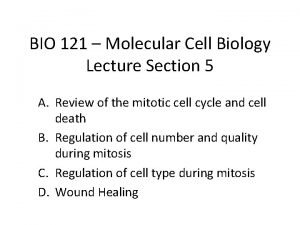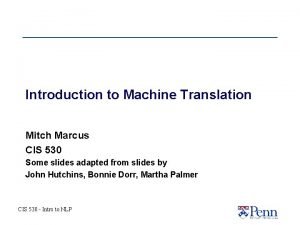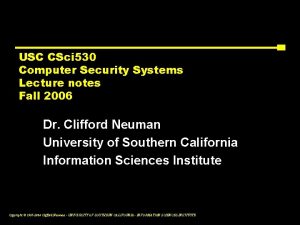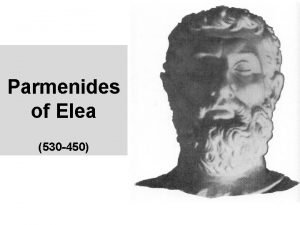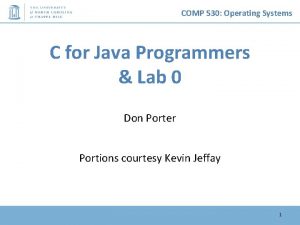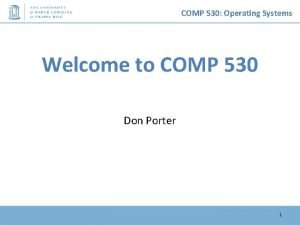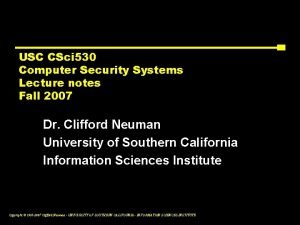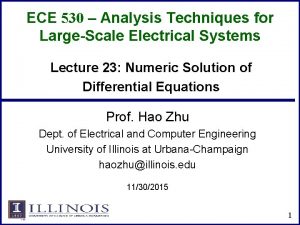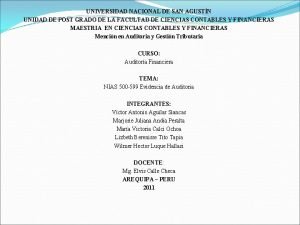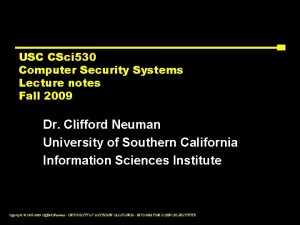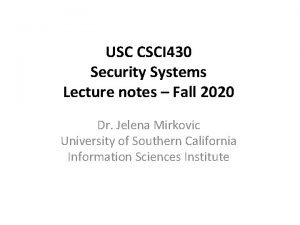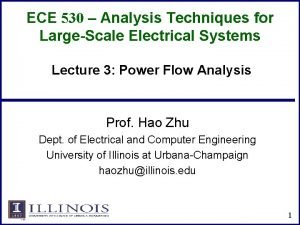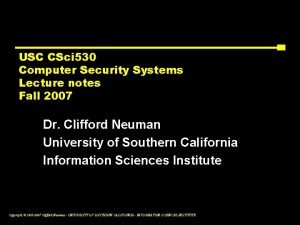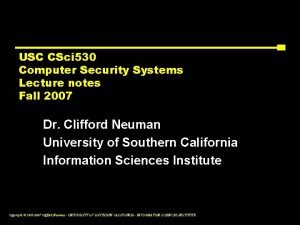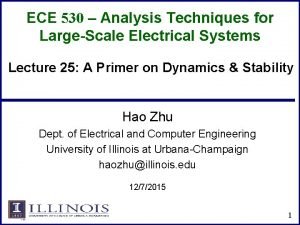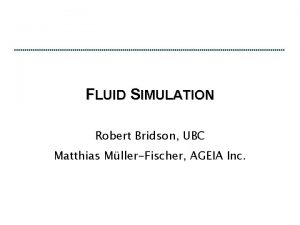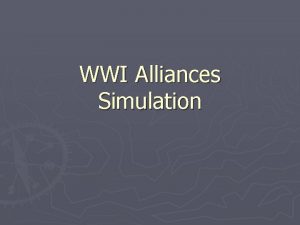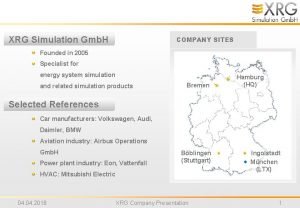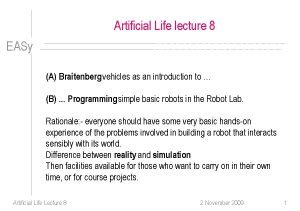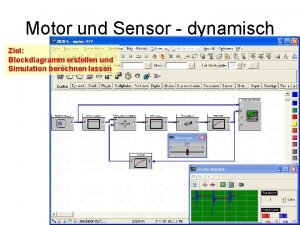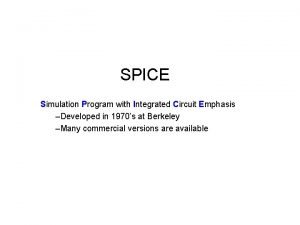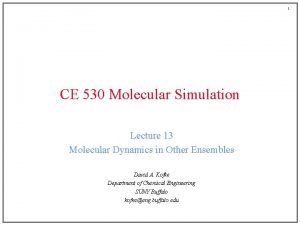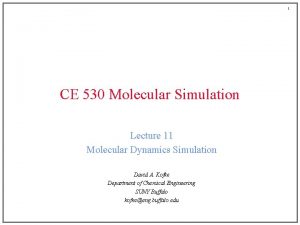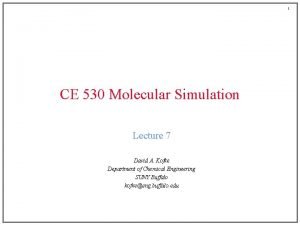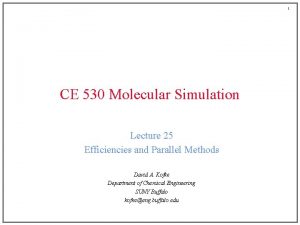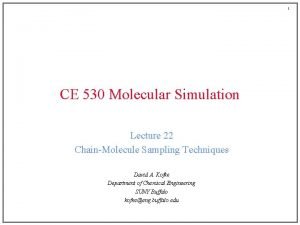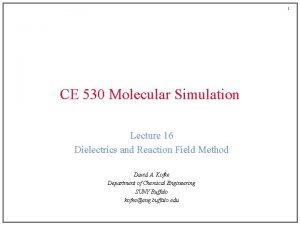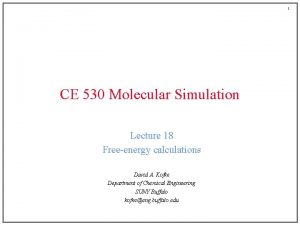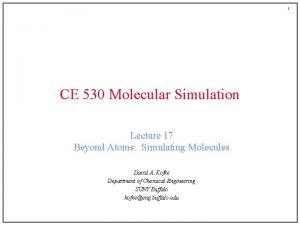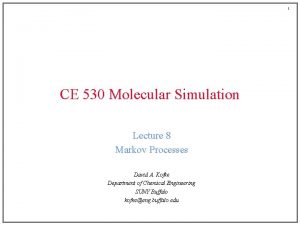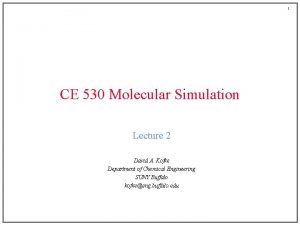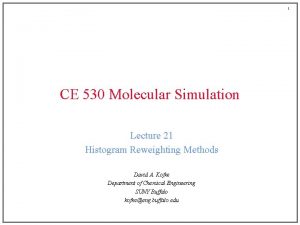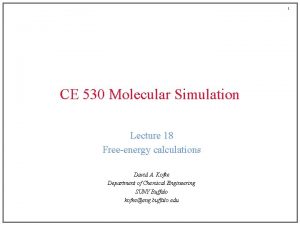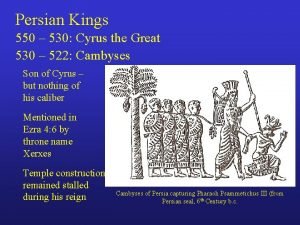1 CE 530 Molecular Simulation Lecture 14 Molecular































- Slides: 31

1 CE 530 Molecular Simulation Lecture 14 Molecular Models David A. Kofke Department of Chemical Engineering SUNY Buffalo kofke@eng. buffalo. edu

2 Review ¡ Monte Carlo • ensemble averaging, no dynamics • easy to select independent variables • lots of flexibility to improve performance ¡ Molecular dynamics • time averaging, yields dynamical properties • extended Lagrangians permit extension to other ensembles ¡ Models • atomic systems only hard sphere, square well Lennard-Jones

3 Modeling Molecules ¡ Quantitative calculations require more realistic treatment of molecular interactions ¡ Quantum mechanical origins ¡ Intermolecular forces ¡ Intramolecular forces ¡ Effects of long-range interactions on properties ¡ Multibody interactions

4 Quantum Mechanical Origins ¡ Fundamental to everything is the Schrödinger equation Nuclear coordinates • • wave function Electronic coordinates • H = Hamiltonian operator • time independent form ¡ Born-Oppenheimer approximation • electrons relax very quickly compared to nuclear motions • nuclei move in presence of potential energy obtained by solving electron distribution for fixed nuclear configuration it is still very difficult to solve for this energy routinely • usually nuclei are heavy enough to treat classically

5 Force Field Methods ¡ Too expensive to solve QM electronic energy for every nuclear configuration ¡ Instead define energy using simple empirical formulas • “force fields” or “molecular mechanics” ¡ Decomposition of the total energy Single-atom energy (external field) Atom-pair contribution Neglect 3 - and higher-order terms 3 -atom contribution ¡ Force fields usually written in terms of pairwise additive interatomic potentials • with some exceptions

6 Contributions to Potential Energy ¡ Total pair energy breaks into a sum of terms Intramolecular only ¡ Ustr stretch ¡ Uvd. W van der Waals ¡ Ubend ¡ Uel electrostatic ¡ Utorsion ¡ Upol polarization ¡ Ucross

7 Contributions to Potential Energy ¡ Total pair energy breaks into a sum of terms Intramolecular only ¡ Ustr stretch ¡ Uvd. W van der Waals ¡ Ubend ¡ Uel electrostatic ¡ Utorsion ¡ Upol polarization ¡ Ucross

8 Contributions to Potential Energy ¡ Total pair energy breaks into a sum of terms Intramolecular only ¡ Ustr stretch ¡ Uvd. W van der Waals ¡ Ubend ¡ Uel electrostatic ¡ Utorsion ¡ Upol polarization ¡ Ucross

9 Contributions to Potential Energy ¡ Total pair energy breaks into a sum of terms Intramolecular only ¡ Ustr stretch ¡ Uvd. W van der Waals ¡ Ubend ¡ Uel electrostatic ¡ Utorsion ¡ Upol polarization ¡ Ucross

10 Contributions to Potential Energy ¡ Total pair energy breaks into a sum of terms Intramolecular only ¡ Ustr stretch ¡ Uvd. W van der Waals ¡ Ubend ¡ Uel electrostatic ¡ Utorsion ¡ Upol polarization ¡ Ucross

11 Contributions to Potential Energy ¡ Total pair energy breaks into a sum of terms Intramolecular only ¡ Ustr stretch ¡ Uvd. W van der Waals ¡ Ubend ¡ Uel electrostatic ¡ Utorsion ¡ Upol polarization ¡ Ucross

12 Contributions to Potential Energy ¡ Total pair energy breaks into a sum of terms Intramolecular only Repulsion ¡ Ustr stretch ¡ Uvd. W van der Waals ¡ Ubend ¡ Uel electrostatic ¡ Utorsion ¡ Upol polarization ¡ Ucross Mixed terms

13 Contributions to Potential Energy ¡ Total pair energy breaks into a sum of terms Intramolecular only Repulsion ¡ Ustr stretch ¡ Uvd. W van der Waals ¡ Ubend ¡ Uel electrostatic ¡ Utorsion ¡ Upol polarization ¡ Ucross Mixed terms

14 Contributions to Potential Energy ¡ Total pair energy breaks into a sum of terms Intramolecular only Repulsion ¡ Ustr stretch ¡ Uvd. W van der Waals ¡ Ubend ¡ Uel electrostatic ¡ Utorsion ¡ Upol polarization ¡ Ucross Mixed terms - + Attraction

15 Contributions to Potential Energy ¡ Total pair energy breaks into a sum of terms Intramolecular only Repulsion ¡ Ustr stretch ¡ Uvd. W van der Waals ¡ Ubend ¡ Uel electrostatic ¡ Utorsion ¡ Upol polarization ¡ Ucross + - Attraction Mixed terms

16 Contributions to Potential Energy ¡ Total pair energy breaks into a sum of terms Intramolecular only Repulsion ¡ Ustr stretch ¡ Uvd. W van der Waals ¡ Ubend ¡ Uel electrostatic ¡ Utorsion ¡ Upol polarization Mixed terms + +- ¡ Ucross + - Attraction + -

17 Contributions to Potential Energy ¡ Total pair energy breaks into a sum of terms Intramolecular only Repulsion ¡ Uvd. W van der Waals ¡ Ustr stretch ¡ Ubend ¡ Upol polarization ¡ Utorsion ¡ Ucross u(N) Mixed terms + +- + +- Attraction u(2) + - + ¡ Uel electrostatic + + u(2) -

18 Contributions to Potential Energy ¡ Total pair energy breaks into a sum of terms Intramolecular only Repulsion ¡ Uvd. W van der Waals ¡ Ustr stretch ¡ Ubend ¡ Upol polarization ¡ Utorsion ¡ Ucross u(N) Mixed terms + +- Attraction u(2) + - + ¡ Uel electrostatic + + u(2) - + +- + -

19 Stretch Energy ¡ Expand energy about equilibrium position (neglect) define minimum harmonic Morse ¡ Model fails in strained geometries • better model is the Morse potential dissociation energy force constant

20 Bending Energy q ¡ Expand energy about equilibrium position (neglect) define minimum harmonic • improvements based on including higher-order terms ¡ Out-of-plane bending u(4) c

21 Torsional Energy ¡ Two new features f • periodic • weak (Taylor expansion in f not appropriate) ¡ Fourier series • terms are included to capture appropriate minima/maxima depends on substituent atoms – e. g. , ethane has three mimum-energy conformations • n = 3, 6, 9, etc. depends on type of bond – e. g. ethane vs. ethylene • usually at most n = 1, 2, and/or 3 terms are included

22 Van der Waals Attraction ¡ Correlation of electron fluctuations + - + ¡ Stronger for larger, more polarizable molecules • CCl 4 > CH 4 ; Kr > Ar > He ¡ Theoretical formula for long-range behavior ¡ Only attraction present between nonpolar molecules • reason that Ar, He, CH 4, etc. form liquid phases ¡ a. k. a. “London” or “dispersion” forces -+ -+

Van der Waals Repulsion ¡ Overlap of electron clouds ¡ Theory provides little guidance on form of model ¡ Two popular treatments inverse power exponential typically n ~ 9 - 12 two parameters ¡ Combine with attraction term • Lennard-Jones model Exp-6 a. k. a. “Buckingham” or “Hill” Beware of anomalous Exp-6 short-range attraction Exp-6 repulsion is slightly softer 23

24 Electrostatics 1. ¡ Interaction between charge inhomogeneities ¡ Modeling approaches • point charges • point multipoles ¡ Point charges • assign Coulombic charges to several points in the molecule • total charge sums to charge on molecule (usually zero) • Coulomb potential very long ranged

25 Electrostatics 2. ¡ At larger separations, details of charge distribution are less important ¡ Multipole statistics capture basic features • Dipole • Quadrupole • Octopole, etc. Vector Tensor ¡ Point multipole models based on long-range behavior • dipole-dipole • dipole-quadrupole • quadrupole-quadrupole Axially symmetric quadrupole

Electrostatics 3. Some Experimental/Theoretical Values 26

27 + +- ¡ Charge redistribution due to influence of surrounding molecules + + + -++ • dipole moment in bulk different + - + from that in vacuum + +- Polarization ¡ Modeled with polarizable charges or multipoles ¡ Involves an iterative calculation • evaluate electric field acting on each charge due to other charges • adjust charges according to polarizability and electric field • re-compute electric field and repeat to convergence ¡ Re-iteration over all molecules required if even one is moved

28 Explicit Multibody Interactions ¡ Axilrod-Teller u(3) • consider response of atoms 2 and 3 to fluctuation in dipole moment of atom 1 • average over all fluctuations in 1 1 2 3

29 Unlike-Atom Interactions ¡ “Mixing rules” give the potential parameters for interactions of atoms that are not the same type • no ambiguity for Coulomb interaction • for effective potentials (e. g. , LJ) it is not clear what to do ¡ Lorentz-Berthelot is a widely used choice ¡ Treatment is a very weak link in quantitative applications of molecular simulation

30 Common Approximations in Molecular Models ¡ Rigid intramolecular degrees of freedom • fast intramolecular motions slow down MD calculations ¡ Ignore hydrogen atoms • united atom representation ¡ Ignore polarization • expensive n-body effect ¡ Ignore electrostatics ¡ Treat whole molecule as one big atom • maybe anisotropic ¡ Model vd. W forces via discontinuous potentials ¡ Ignore all attraction ¡ Model space as a lattice • especially useful for polymer molecules Qualitative models

31 Summary ¡ Intermolecular forces arise from quantum mechanics • too complex to include in lengthy simulations of bulk phases ¡ Empirical forms give simple formulas to approximate behavior • intramolecular forms: bend, stretch, torsion • intermolecular: van der Waals, electrostatics, polarization ¡ Unlike-atom interactions weak link in quantitative work
 01:640:244 lecture notes - lecture 15: plat, idah, farad
01:640:244 lecture notes - lecture 15: plat, idah, farad Enteroendocrine cell
Enteroendocrine cell Molecular cell biology lecture
Molecular cell biology lecture Cell and molecular biology lectures
Cell and molecular biology lectures Chinese to english translation
Chinese to english translation Csci 530
Csci 530 Principle of non contradiction
Principle of non contradiction Comp 530
Comp 530 Comp 530
Comp 530 Netcheque
Netcheque Ece 530
Ece 530 Bioc 530
Bioc 530 Nia 580
Nia 580 Usc csci 530
Usc csci 530 Csci430
Csci430 Ece 530
Ece 530 Csci 530 usc
Csci 530 usc Csci 530
Csci 530 Nep 315
Nep 315 Ece 530
Ece 530 Ar 530-1
Ar 530-1 Covalent bond boiling point
Covalent bond boiling point Ionic covalent metallic
Ionic covalent metallic Zinc oxide + nitric acid → zinc nitrate + water
Zinc oxide + nitric acid → zinc nitrate + water The hind leg bones in a whale are examples of
The hind leg bones in a whale are examples of Matthias müller-fischer
Matthias müller-fischer Ww1 alliance simulation game
Ww1 alliance simulation game Topaz management simulation
Topaz management simulation Xrg simulation
Xrg simulation Braitenberg vehicles simulation
Braitenberg vehicles simulation Oszilloskop simulation
Oszilloskop simulation Spice (simulation program with integrated circuit emphasis)
Spice (simulation program with integrated circuit emphasis)


